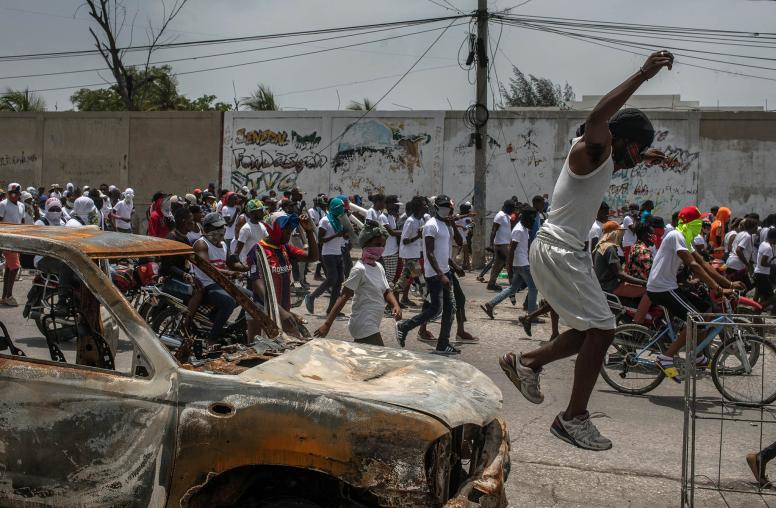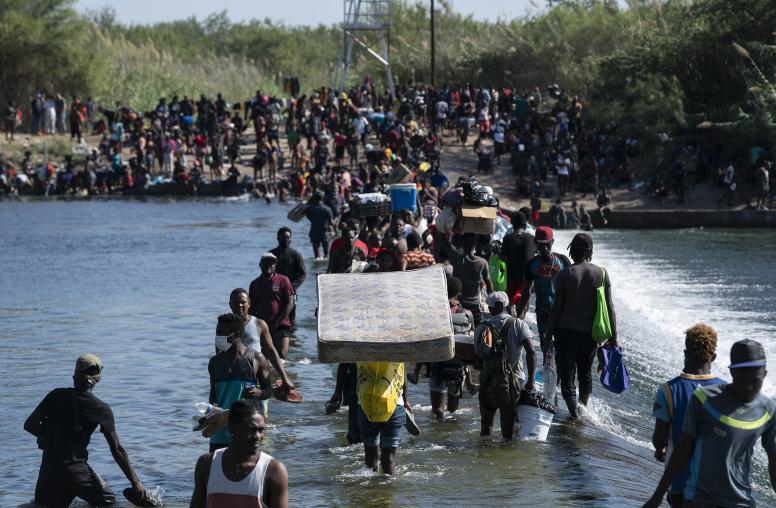What’s the State of Play on the Global Fragility Act?
The release of 10-year plans could pave the way for more effective U.S. conflict stabilization.
The White House’s recent release of 10-year stabilization and conflict prevention plans marks another milestone in U.S. efforts to implement the closely watched Global Fragility Act (GFA). The legislation received bipartisan support in the U.S. Congress before being signed into law by then President Donald Trump in 2019. It requires the U.S. government to develop a strategy for preventing the drivers of violent conflict and extremism, and to test a more coordinated, cost-effective and sustained U.S. approach in hot spots around the world.

To that end, the White House announced a series of partnerships last year with Haiti, Libya, Mozambique and Papua New Guinea, along with countries in the region of coastal West Africa, including Benin, Côte d’Ivoire, Ghana, Guinea and Togo. The GFA mandates 10-year plans to be implemented across the partner countries. Last month, following consultations with national and local leaders and civil society groups, the State Department released the long-awaited plans.
USIP’s Corinne Graff explains how the new approach to stabilization and conflict prevention is different from previous U.S. engagements, where implementation efforts stand and what to look out for going forward. U.S. reform efforts, beginning with implementation of these plans, face a long road and challenges ahead.
Why do the GFA and these 10-year stabilization plans matter?
The 10-year plans are not expected to have an immediate impact on U.S. national security or regional stability. But if the modest U.S. investments and reforms that they entail are sustained over a decade, this longer-term cross-country initiative could well result in improved stabilization outcomes in the partner countries, and a road map for more efficient U.S. engagement to mitigate conflicts around the world in the future, including in critical regions like Central America, where violence drives migration to the United States.
The new U.S. approach comes at an important time, as countries from Bangladesh to Ethiopia, Peru and Sri Lanka are rocked by political upheaval and instability. Across Latin America, Africa and Asia, countries have been particularly hard hit by inflation, skyrocketing government debt and a deepening world food crisis — made worse by Russia’s invasion of Ukraine.
Improving the U.S. approach to stabilization and conflict mitigation bolsters U.S. soft power and helps stem the tide of instability and autocracy at a particularly perilous moment for the partner countries.
What’s new in the country plans?
The plans themselves are innovative because they reflect wider-than-usual U.S. consultations and engagement with a broader cross-section of leaders and groups who are involved in conflict or directly affected by it, particularly in marginalized communities. While no guarantee of success, expanded U.S. engagement with local leaders in southern Libya and Mozambique’s Cabo Delgado, for example, is an important first step toward an approach that will provide better insight into conflict dynamics and help build buy-in for U.S. objectives.
Many of the plans also reflect greater emphasis on professionalizing security forces and reforming judicial institutions — both key to stability in marginalized communities where abuses committed by security services and lack of access to courts stoke grievances. The emphasis in some plans on strengthening the partner government’s ability to manage donor aid can help make assistance dollars go further.
In the past, the U.S. government’s approach to conflict and violent extremism has been criticized for being too reactive and failing to prioritize the root causes of instability before full-blown crises erupt. The GFA is intended to change that. It focuses on the economic and political drivers of instability, like obstacles to women’s participation in the economy and political representation for marginalized groups. These investments are intended to help ward off future spirals of violence before more costly military or humanitarian interventions are required.
The GFA also places a premium on opening new lines of communication and deepening collaboration across U.S. agencies.
What comes next in implementation?
Now that the 10-year plans have been finalized, U.S. field missions will begin spending funds on their programmatic priorities. Congress has authorized up to $200 million a year and appropriated $135 million for FY 2023 for a Prevention and Stabilization Fund (PSF), which will be divvied up and made available to the relevant field missions. Most of this funding is expected to be applied to implementing the 10-year plans.
The release of the plans signals that there continues to be momentum behind implementation efforts at the field mission level. However, the significant delays in implementation are also indicative of serious structural obstacles — possibly staffing constraints, lack of training or bureaucratic obstacles to coordination. The GFA requires that departments report back to Congress on obstacles to implementation, and these reports can be expected to shed light on the specific causes of the delays since the law passed in late 2019.
Traditionally, monitoring and evaluation have focused on the impacts of specific programs, such as the impact of USAID’s Office of Transition Initiatives program in northern Ghana on addressing grievances that are fueling farmer-herder conflict in that region. Going forward, field missions in the GFA partner countries will also need to develop metrics to evaluate their efforts at the country level — across different aid and security programs and diplomatic engagements within a country — to determine the impact of U.S. efforts year-over-year under the GFA plans.
How will we know if the GFA is working?
One short-term benchmark will be the speed at which programs receive funding, and the extent to which the programs funded are innovative. For example, given that country ownership of prevention and stabilization objectives is emphasized under the law, the funding of programs that are developed in partnership with national and local stakeholders and in a transparent manner would reflect an innovative programmatic approach. At the same time, any indication that programs across sectors have been designed to be mutually reinforcing would signal the kind of innovative approach that is intended under the law.
Finally, another indicator of progress will be the level of congressional support provided for the PSF in the next fiscal year. Congressional stakeholders will be watching country implementation efforts at the field level closely over the coming year and are likely to make funding decisions based on the results they see on the ground.

